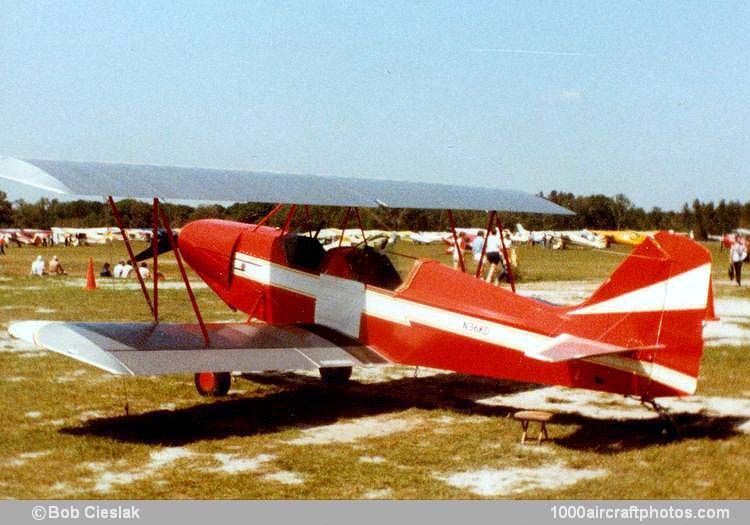A modified Kelly-D was developed on the basis of experience with these aircraft, to offer greatly improved ground handling and a lower landing speed. It used a new wing section and has a 2 ft (61 cm) increase in span. This version became the only one released for home building and pre-welded component parts for the Kelly-D were available, the details below refer to it. At least fifteen Kelly-Ds have been constructed.
The pictured aircraft was constructed by Rogers and subsequently registered to Robert D. Robinson of Warrensburg on February 22, 1985, the aircraft was listed as a Robinson/Rogers Kelly-D; the aircraft changed hands on September 19, 1992. Latest owner, since December 16, 2013, is Larry Plank of Perkins, Oklahoma.
Type: Two-seat homebuilt aerobatic biplane.
Airframe: Single-bay biplane, with wire-braced N type interplane struts each side. Inverted V-center section struts and streamline section landing and flying wires. Wing section NACA 4412. Dihedral 3°, on lower wings only. Incidence 2° on both wings. Constant chord, with no sweepback but considerable stagger. Wooden two-spar structure, with fabric covering. Aerodynamically balanced ailerons of wooden construction, fabric covered, on lower wing only. Conventional welded steel tube fuselage and wire-braced tail unit, with fabric covering. Fixed incidence tail plane. Trim tab in port elevator.
Landing gear: Non-retractable tail wheel type. Two side Vs and half-axles hinged to fuselage structure. Shock absorption of main units by steel coil spring on each compression strut. Main wheel tires size 6.00-6, pressure 1.24 bars (18 lb/sq.in, 87.89 kg/sq.m). Tail wheel diameter 6 in (15 cm). Cleveland hydraulic disc brakes. Fairings over main wheels optional.
Power plant: An 115 hp Avco Lycoming O-235 flat-four engine, driving a Sensenich two-blade fixed-pitch propeller. Fuel tank in fuselage, aft of firewall, with capacity of 24 gal (91 l). Refueling point on upper surface of fuselage, forward of front cockpit. Oil capacity 1.5 gal (5.7 l).
Accommodation: Two seats in tandem in open cockpits. Baggage space aft of pilot's seat in rear cockpit, capacity 40 lb (18 kg).
Systems: Hydraulic system for brakes only. Electrical system includes starter/generator and 12V storage battery.
Avionics and equipment: Genave Alpha 200B radio. Navigation lights.
